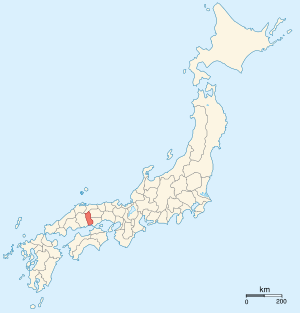
Bitchu Province
Encyclopedia

Provinces of Japan
Before the modern prefecture system was established, the land of Japan was divided into tens of kuni , usually known in English as provinces. Each province was divided into gun ....
of Japan
Japan
Japan is an island nation in East Asia. Located in the Pacific Ocean, it lies to the east of the Sea of Japan, China, North Korea, South Korea and Russia, stretching from the Sea of Okhotsk in the north to the East China Sea and Taiwan in the south...
on the Inland Sea side of western Honshū
Honshu
is the largest island of Japan. The nation's main island, it is south of Hokkaido across the Tsugaru Strait, north of Shikoku across the Inland Sea, and northeast of Kyushu across the Kanmon Strait...
, in what is today western Okayama Prefecture
Okayama Prefecture
is a prefecture of Japan located in the Chūgoku region on Honshū island. The capital is the city of Okayama.- History :During the Meiji Restoration, the area of Okayama Prefecture was known as Bitchū Province, Bizen Province and Mimasaka Province.- Geography :...
. It was sometimes called , with Bizen
Bizen Province
was a province of Japan on the Inland Sea side of Honshū, in what is today the southeastern part of Okayama Prefecture. It was sometimes called , with Bitchu and Bingo Provinces. Bizen borders Mimasaka, Harima, and Bitchū Provinces....
and Bingo
Bingo Province
was a province of Japan on the Inland Sea side of western Honshū, comprising what is today the eastern part of Hiroshima Prefecture. It was sometimes called , with Bizen and Bitchu Provinces. Bingo bordered Bitchū, Hōki, Izumo, Iwami, and Aki Provinces....
Provinces. Bitchu bordered Hōki
Hoki Province
was an old province of Japan in the area that is today the western part of Tottori Prefecture. It was sometimes called . Hōki bordered on Inaba, Mimasaka, Bitchū, Bingo, and Izumo Provinces....
, Mimasaka
Mimasaka Province
or was a province of Japan in the part of Honshū that is today northeastern Okayama Prefecture. Mimasaka bordered Bitchū, Bizen, Harima, Hōki, and Inaba Provinces....
, Bizen
Bizen Province
was a province of Japan on the Inland Sea side of Honshū, in what is today the southeastern part of Okayama Prefecture. It was sometimes called , with Bitchu and Bingo Provinces. Bizen borders Mimasaka, Harima, and Bitchū Provinces....
, and Bingo
Bingo Province
was a province of Japan on the Inland Sea side of western Honshū, comprising what is today the eastern part of Hiroshima Prefecture. It was sometimes called , with Bizen and Bitchu Provinces. Bingo bordered Bitchū, Hōki, Izumo, Iwami, and Aki Provinces....
Provinces.
The ancient capital and temples
Provincial temple
Emperor Shōmu of Japan established so-called provincial temples in each province of Japan...
were built around Soja
Soja, Okayama
is a city located in Okayama Prefecture, Japan.As of April 30, 2011, the city has an estimated population of 67,357, with a household number of 24,623, and the density of 317.72 persons per km². The total area is 212.00 km².The city was founded on March 31, 1954...
. For much of the Muromachi Period
Muromachi period
The is a division of Japanese history running from approximately 1336 to 1573. The period marks the governance of the Muromachi or Ashikaga shogunate, which was officially established in 1338 by the first Muromachi shogun, Ashikaga Takauji, two years after the brief Kemmu restoration of imperial...
, the province was dominated by the Hosokawa clan
Hosokawa clan
The ' was a Japanese samurai clan, descended from Emperor Seiwa and a branch of the Minamoto clan, by the Ashikaga clan. It produced many prominent officials in the Ashikaga shogunate's administration. In the Edo period, the Hosokawa clan was one of the largest landholding daimyo families in Japan...
, who resided on Shikoku
Shikoku
is the smallest and least populous of the four main islands of Japan, located south of Honshū and east of the island of Kyūshū. Its ancient names include Iyo-no-futana-shima , Iyo-shima , and Futana-shima...
and allowed the province a degree of independence. By the Sengoku Period
Sengoku period
The or Warring States period in Japanese history was a time of social upheaval, political intrigue, and nearly constant military conflict that lasted roughly from the middle of the 15th century to the beginning of the 17th century. The name "Sengoku" was adopted by Japanese historians in reference...
, other clans fought over Bitchu, and Oda Nobunaga
Oda Nobunaga
was the initiator of the unification of Japan under the shogunate in the late 16th century, which ruled Japan until the Meiji Restoration in 1868. He was also a major daimyo during the Sengoku period of Japanese history. His opus was continued, completed and finalized by his successors Toyotomi...
and Mori Terumoto
Mori Terumoto
Mōri Terumoto , son of Mōri Takamoto and grandson and successor of the great warlord Mōri Motonari, fought against Toyotomi Hideyoshi but was eventually overcome, participated in the Kyūshū campaign on Hideyoshi's side and built Hiroshima Castle, thus essentially founding Hiroshima.Terumoto was a...
were fighting in the province when Oda died, leading to a division of the province. After 1600, the province was divided among a variety of han (fiefs), and included a number of castles. By the time the provinces were reorganized into prefectures, the dominant city was the port, Kurashiki
Kurashiki, Okayama
is a historic city located to the west of Okayama Prefecture, Japan, sitting on the Takahashi River, on the coast of the Inland Sea.As of April 2010, the city has a population of 473,392. The total area is .-History:...
.

